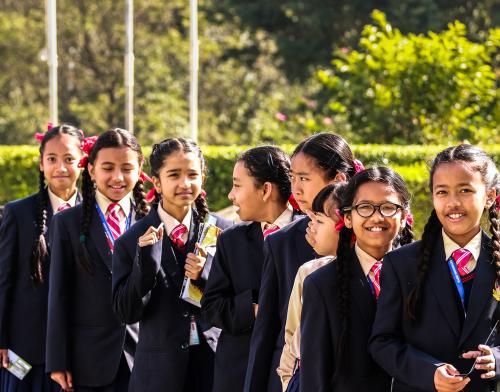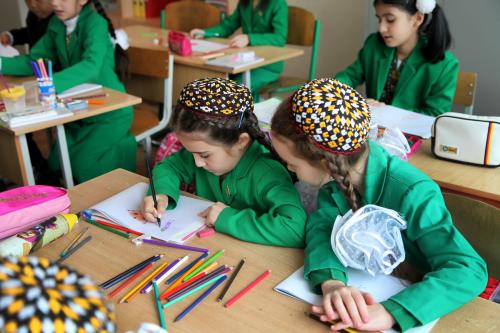Even before the COVID-19 pandemic, existing structural and socio-economic inequities in Nepal excluded most adolescent girls from schooling. More than 80 percent of girls who have left school did not find the support needed for systemic issues like forced marriage, excessive household work, menstruation, harassment, and trafficking. As gender remains the single strongest determinant of school participation among adolescents, it is important to understand the social-emotional needs of adolescent girls and how can they be addressed.
What is transformative social-emotional learning?
Transformative social-emotional learning (TSEL) holds promise to address girls’ needs so they can reap both the academic and overall emotional and mental well-being benefits of attending school. However, in order for girls to access TSEL, female teachers must also have opportunities to strengthen their own emotional literacy, examine and reflect critically on the roots of inequity, and foster collaborative solutions to these community and societal problems. To ensure gender equity in Nepal, it is imperative that we support the emotional literacy of female teachers, especially those teaching at the secondary level.
As an Echidna Global Scholar, I conducted research in July and August of 2022 to identify the social-emotional needs of adolescent Nepalese girls and the roles of female teachers in addressing those needs and to better understand the support teachers themselves are (or are not) receiving. I obtained data and insights using mixed methods research with 249 adolescent girls, 15 female teachers, and six school leaders (principals, vice-principals, and school coordinators) in seven secondary-level community schools and two learning centers from three different districts—Kathmandu, Lalitpur, and Kavrepalanchowk—in Bagmati Province, as well as an extensive review of research and policy documents.
My research uncovered startling findings.
Adolescent girls are in an urgent need of TSEL support at school
- Challenges facing adolescent girls: Around 52 percent of the girls in my study reported hating themselves and around 64 percent felt that they were not loved. Eighty-five percent of the girls reported that they cannot concentrate on their studies because of fatigue and stress related to the image they believe that their family and friends have of them.
- Emotional challenges related to menstruation: In my research, 68 percent of the girls reported missing class due to “illness.” The vast majority—83 percent of the students surveyed—stated they needed support to tackle the psychological distress associated with menstruation and frequent mood swings during puberty.
- Increased socialization with peers and self-expression: Many adolescent girls reported limited opportunities to socialize with their peers, and around 95 percent said social media was their only space to explore and express themselves. Reflective of the restrictive sociocultural settings they inhabit, the girls reported having few friends outside of school and no social groups to share their everyday challenges or even hang out with.
- Support and mentorship from female teachers: The girls were eager to receive support and understanding from their female teachers. However, they complained that their female teachers did not show interest in coaching or counseling them, even when they shared their problems, thus making them more uncomfortable sharing anything further.
But female teachers report lack of understanding about TSEL compared to what adolescent girls need
- Navigating academic and social challenges: Students look up to their female teachers and expect them to help navigate challenges, such as school performance, self-expression, menstruation, and how to tackle problems related to gender, bullying, and harassment. Yet, less than a third of the girls (30.5 percent) felt confident that their female teachers could do so.
- Role modeling: Around 76.3 percent of the girls believe that their female teachers should play a significant role in helping them achieve their goals and serve as examples for success. However, out of the seven schools we visited, only one school had a female teacher who was specifically focused on mentoring students—especially adolescent girls—to help them navigate gender-based concerns and problems. Sadly, she also expressed her limitations in providing the needed support to the girls.
Female teachers need TSEL to support adolescent girls
- Better tools and opportunity: Teachers often lack resources about the social-emotional needs of adolescent girls. They reported that when given training, TSEL is not included and that they must often take on the responsibility themselves, which can become a financial and social burden.
- Trauma response training: The teachers reported that most of the girls studying in community schools come from lower economic backgrounds and are most prone to issues like abuse and sexual harassment. However, the teachers feel they lack competence in addressing these social problems.
- Belonging: Like their students, teachers often feel isolated and sometimes subject to bullying and intimidation by their peers, especially males. Lacking a feeling of belonging and agency in the current education system leads them to first seek support for themselves before supporting their students.
Recommendations
Based on these findings, Nepalese policymakers, local governments, principals, and advocates must work to ensure female teachers have the ability to address adolescent girls’ social-emotional needs. Specifically, these should include:
1. Local government should build foundational support and incorporate TSEL in trainings so that female teachers feel more included and connected to the system.
Local government should work in collaboration with school leaders, female teachers, and academics to create and align long-term TSEL-related initiatives. They should also work to develop and disseminate consistent messaging around this topic and provide sufficient funding to reach long-term objectives of helping girls realize the benefits of school.
2. Both the private sector and nongovernmental organizations should strengthen female teachers’ TSEL knowledge, skills, beliefs, and practices.
Teacher professional development must include skills and knowledge ready for immediate application and developing teachers’ ability to meet students’ needs. Similarly, it is important to engage teachers in such a way that they can incorporate social emotional learning into their teaching practices.
3. Schools should promote the social-emotional well-being of teachers—prioritizing female teachers—and ensure autonomy in the school climate.
Creating a psychologically safe and respectful environment is the first step toward increasing female teachers’ agency. Schools can then create strong TSEL guidelines and promote them in the classroom by making teachers’—especially female teachers’—self-esteem a key priority, leading to their improved social-emotional well-being.
When teachers feel like they belong, have autonomy, and feel competent, it makes them better equipped to be role models. With better policies and programming to support teachers’ educational practice and emotional literacy, adolescent girls can thrive in secondary school. This means adolescent girls will graduate from their schools with better emotional and mental well-being, improved learning outcomes, strong social-emotional competencies, and an increased sense of belonging and agency.
I will present more detailed findings and recommendations from this work at the research and policy symposium on gender equality in and through education during my workshop on “Why emotions matter: Promoting female teachers and gender-transformative social-emotional learning in Nepal” on December 6, from 8 to 9:30 am ET/6:45 to 8:15 pm Kathmandu. Register here.
The Brookings Institution is committed to quality, independence, and impact.
We are supported by a diverse array of funders. In line with our values and policies, each Brookings publication represents the sole views of its author(s).






Commentary
Why promoting female teachers’ social-emotional learning matters
November 29, 2022